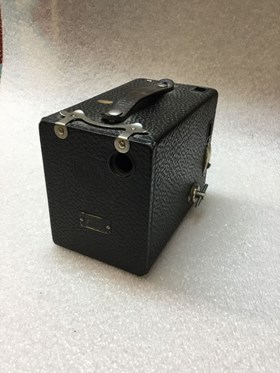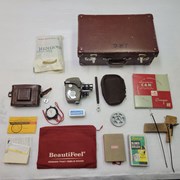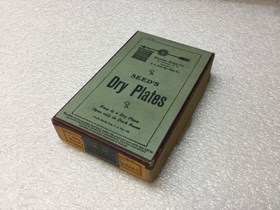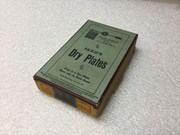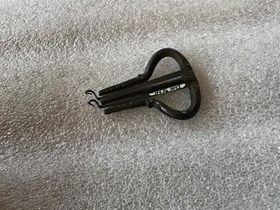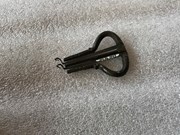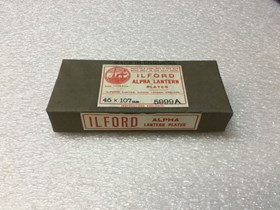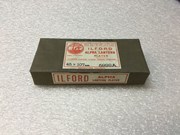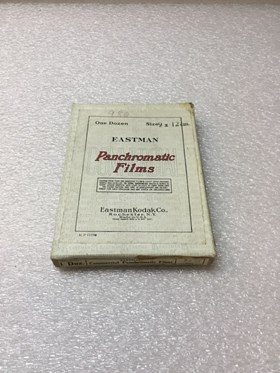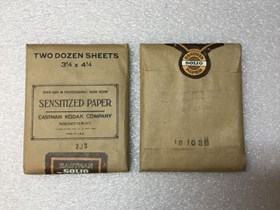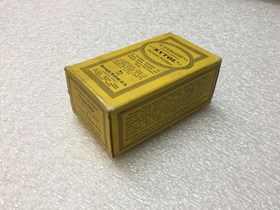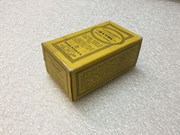Narrow Results By
Brownie Camera
https://archives.whyte.org/en/permalink/artifact104.41.0176
- Date
- 1901 – 1935
- Material
- leather; metal; cardboard; glass
- Catalogue Number
- 104.41.0176
- Description
- Dark brown/black Kodak No. 2 Brownie camera with a leather strap that has “BROWNIE’ stamped on it on the top, two viewfinders [one on top, one on the right side], a back panel that hinges open to access the film compartment [this compartment is metal and removable], a thin metal rod that rotates th…
1 image
- Title
- Brownie Camera
- Date
- 1901 – 1935
- Material
- leather; metal; cardboard; glass
- Dimensions
- 11.3 x 9.4 x 14.4 cm
- Description
- Dark brown/black Kodak No. 2 Brownie camera with a leather strap that has “BROWNIE’ stamped on it on the top, two viewfinders [one on top, one on the right side], a back panel that hinges open to access the film compartment [this compartment is metal and removable], a thin metal rod that rotates the film inside, and the lever that triggers the lens. Attached to the back is a small rectangular metal plaque with the manufacturer’s details and above it is an embossed stamp that identifies this camera as being “No. 120.”
- Credit
- Gift of Eddie Hunter, Banff, 1995
- Catalogue Number
- 104.41.0176
Images
This material is presented as originally created; it may contain outdated cultural descriptions and
potentially offensive content.
Read more.
Camera; Equipment Case
https://archives.whyte.org/en/permalink/artifact104.41.0287a-m
- Date
- 2024
- Catalogue Number
- 104.41.0287a-m
- Description
- Custom red brown camera case containing a camera, recorder, and various equipment and accessories.a) Red brown suitcase that has been customized to carry cameras and their equipment. The outside has reinforced leather corners and silver hardware. The outside has the initials “J. R. G.” on the top a…
1 image
- Title
- Camera; Equipment Case
- Date
- 2024
- Dimensions
- 13.5 x 41.0 cm
- Description
- Custom red brown camera case containing a camera, recorder, and various equipment and accessories.a) Red brown suitcase that has been customized to carry cameras and their equipment. The outside has reinforced leather corners and silver hardware. The outside has the initials “J. R. G.” on the top and bottom sides, as well as under the handle. Inside, the case has a brown plaid lining. The bottom of the case has been fitted with a custom made wood, cream coloured apparatus that is designed to hold (c). It comes apart into two pieces - the base, which is not removable, and the lid, which slides out to the right once it has been unhooked from the latch built into the base n the left hand side. The lid of the suitcase reads “J. R. GRICE / 9920 - 75 ST / EDMONTON / ALBERTA”. The foam on the apparatus has worn off, leaving black dust like particles in the suitcase. There are a set of two keys hanging from a brown strap connecting the lid to the base in the center of the suitcase.b) Silver and black camera in a brown leather case. The camera is secured in the case with a wide, flat screw at the base. The camera also comes with its original document outlining the features and instructions of the camera. The camera itself is a Olympus Chrome Six. According to the document, the camera was used to produce “ (12) 6x6cm photos or (16) 4.5x6cm photos on a roll of 120 film”. The camera is black leather with a silver body. There are two silver knobs on the base. The top has four knobs, a viewfinder, and a mount for flash. The smallest knob next to the viewfinder is used to release the lens, which opens from a square panel in the front. The lens is a coated Olympus Zuiko lens. The brown case is Olympus brand and is custom fitted to the camera model. It opens from the top and has two snaps that secure it to the base of the case. A small flap can be opened to allow the camera to be used while remaining in the case. The strap that connects the top of the case to the bottom reads “J. R. GRICE / 9920 - 75 ST / EDMONTON / ALBERTA”. There is a short, thin strap that attaches to either side of the case by metal hardware - one side is broken, the leather has split. The case shows some wear - the connecting middle strap has a large horizontal tear at the seam, while the lens flap has a smaller horizontal tear on the right hand side. c) Green, silver and black recorder that has a strap, brown cloth case and spare reel. The brand on the case, recorder and strap is labeled as Sankyo. The recorder is a muted green colour, with black and silver components. It has three lenses on the front with metal lens caps, The viewfinder is clear. The strap is made of silver components and brown braided cord. The case is brown cloth with a gold zipper, with Sankyo Japan embossed on the side. The reel is made of grey plastic and branded as Kodak, but is believed to work with the recorder. d) Black and white stop watch on a red cord. Was likely used to time exposure times. e) Viewfinder in its original box. Brand is “Watameter”.f) Light meter on a silver snake-chain in its original box. Still operable.g) Blower brush in its original box. h) Handmade camera mount made from wood with attached trigger. There is also a spare trigger wire. i) Film reel it its original box. Reel is empty.j) Bag of miscellaneous bulbs, two of which are for a Sylvanus projector. One is brand new in box. k) Red cloth bag. Front reads “BeautifFeel / Design that feels good” while the bottom says “every woman deserves a pair”l) Miscellaneous papers detailing movie film features and instructions. Have been folded, so they are creased.
- Credit
- Gift of Janet Grice, Banff, 2024
- Catalogue Number
- 104.41.0287a-m
Images
This material is presented as originally created; it may contain outdated cultural descriptions and
potentially offensive content.
Read more.
- Date
- 1883 – 1926
- Material
- cardboard; metal; glass;
- Catalogue Number
- 104.41.0129 a,b
- Description
- Two camera lenses housed in a repurposed Hammond box with “OLD ‘ADON’ Telephoto in shutter circa 1990’s” written in black ink on the front.The larger lens with shutter was manufactured by Bausch & Lomb Optical Co., originally a company that produced prescription eye-wear in the mid to late-1800s be…
1 image
- Title
- Camera Lenses
- Date
- 1883 – 1926
- Material
- cardboard; metal; glass;
- Dimensions
- 5.7 x 7.8 x 14.5 cm
- Description
- Two camera lenses housed in a repurposed Hammond box with “OLD ‘ADON’ Telephoto in shutter circa 1990’s” written in black ink on the front.The larger lens with shutter was manufactured by Bausch & Lomb Optical Co., originally a company that produced prescription eye-wear in the mid to late-1800s before expanding into camera lenses and microscopes/telescopes towards the turn of the century. The company was founded in Rochester NY.The smaller lens was manufactured by Gundlach-Manhattan Optical Co., a merged company between Gundlach Optical Co. and Manhattan Optical Co. that took place in 1902, which produced various kinds of bellows cameras. Both companies were based in Rochester NY prior to merging.
- Credit
- Gift of Nicholas Morant, Banff, 2006
- Catalogue Number
- 104.41.0129 a,b
Images
This material is presented as originally created; it may contain outdated cultural descriptions and
potentially offensive content.
Read more.
Exposure Plates
https://archives.whyte.org/en/permalink/artifact104.41.0207
- Date
- 1902 – 1920
- Material
- cardboard; paper; glass;
- Catalogue Number
- 104.41.0207
- Description
- Box of one dozen 3 1/4 x 5 1/2 glass Seed’s Dry Plates with cut paper adhesive tape around the edges and bottom and manufacturer details printed on a pale green background throughout the lid. These dry plates were invented by M.A. Seed in 1879 and became very popular with photographers as the plate…
1 image
- Title
- Exposure Plates
- Date
- 1902 – 1920
- Material
- cardboard; paper; glass;
- Dimensions
- 3.0 x 9.3 x 15.0 cm
- Description
- Box of one dozen 3 1/4 x 5 1/2 glass Seed’s Dry Plates with cut paper adhesive tape around the edges and bottom and manufacturer details printed on a pale green background throughout the lid. These dry plates were invented by M.A. Seed in 1879 and became very popular with photographers as the plates came pre-prepared with the emulsion layer already applied - prior to “dry” plates, photographers would need portable dark rooms in which they would create their liquid emulsions prior to taking a photograph [known as “wet” plates]. Seed’s dry plates still required they be opened in a dark room, but this could be accomplished in the field by placing a dark sheet over the camera while loading and unloading the plates. In 1902, Eastman Kodak purchased Seed’s company [Seed Dry Plate Co.], but continued to capitalize on his name due to its reputation among consumers.
- Credit
- Gift of Robert Crosby Family, Banff, 1998
- Catalogue Number
- 104.41.0207
Images
This material is presented as originally created; it may contain outdated cultural descriptions and
potentially offensive content.
Read more.
- Date
- 1900 – 1930
- Material
- metal
- Catalogue Number
- 104.36.0003
- Description
- Lyre shaped cast iron frame with a third cast iron leg from the top of the harp down the middle between the outer legs. A double, flat, flexible, thin, vibrating tongue passes down on either side of the central leg to the end of the harp where the ends turn up at sharp right angles, ending in wire …
1 image
- Title
- Jew's Harp
- Date
- 1900 – 1930
- Material
- metal
- Dimensions
- 2.2 x 5.6 x 6.9 cm
- Description
- Lyre shaped cast iron frame with a third cast iron leg from the top of the harp down the middle between the outer legs. A double, flat, flexible, thin, vibrating tongue passes down on either side of the central leg to the end of the harp where the ends turn up at sharp right angles, ending in wire like hooks. The flexible tongue tapers from .3 cm wide to less than .1 cm at the hooked end. A series of three small, shallow, notches in the middle of each outer leg on the under side.
- Subject
- Whyte home
- households
- entertainment
- pastime
- Annie White
- music
- sound
- song
- accessories
- equipment
- Credit
- Gift of Catharine Robb Whyte, O. C., Banff, 1979
- Catalogue Number
- 104.36.0003
Images
This material is presented as originally created; it may contain outdated cultural descriptions and
potentially offensive content.
Read more.
Lantern Plates
https://archives.whyte.org/en/permalink/artifact104.41.0206
- Date
- 1889 – 1910
- Material
- paper; glass;
- Catalogue Number
- 104.41.0206
- Description
- One paper-wrapped package of 45x107mm Ilford Alpha Lantern Plates with white and red paper adhesive labels on the top and front of the package containing manufacturer details. These lantern plates would serve as the positive mount for the lantern slide made from the original negative. Lantern slide…
1 image
- Title
- Lantern Plates
- Date
- 1889 – 1910
- Material
- paper; glass;
- Dimensions
- 2.0 x 11.6 x 5.3 cm
- Description
- One paper-wrapped package of 45x107mm Ilford Alpha Lantern Plates with white and red paper adhesive labels on the top and front of the package containing manufacturer details. These lantern plates would serve as the positive mount for the lantern slide made from the original negative. Lantern slides are glass-based transparencies that were displayed by being projected through an early projector called a magic lantern. Starting as hand-painted images on glass, lantern slides quickly adapted to first black-and-white and then colour photography and faded from popularity with the rise of celluloid film and motion pictures.
- Credit
- Gift of Robert Crosby Family, Banff, 1998
- Catalogue Number
- 104.41.0206
Images
This material is presented as originally created; it may contain outdated cultural descriptions and
potentially offensive content.
Read more.
Panchromatic Film
https://archives.whyte.org/en/permalink/artifact104.41.0201
- Date
- 1906 – 1923
- Material
- cardboard; paper;
- Catalogue Number
- 104.41.0201
- Description
- One box of a dozen 9x12cm Eastman Commercial Panchromatic Films - unopened. The box has a large paper label on the lid containing the manufacturer and development details throughout, as well as “9.80” written in pencil at the top. The edges and bottom of the box are sealed with brown paper adhesive…
1 image
- Title
- Panchromatic Film
- Date
- 1906 – 1923
- Material
- cardboard; paper;
- Dimensions
- 1.5 x 10.0 x 13.7 cm
- Description
- One box of a dozen 9x12cm Eastman Commercial Panchromatic Films - unopened. The box has a large paper label on the lid containing the manufacturer and development details throughout, as well as “9.80” written in pencil at the top. The edges and bottom of the box are sealed with brown paper adhesive tape, the right-hand side is stamped with “DEVELOP BEFORE APRIL 1923.”Panchromatic film is a kind of black-and-white emulsion that is sensitive to all visible light wavelengths and creates realistic photographs - it could also be used successfully for colour and black-and-white motion pictures as early as 1913. One downside to panchromatic film was that it had to be developed in complete darkness as it was sensitive to the red lights standard in many darkrooms.
- Credit
- Gift of Robert Crosby Family, Banff, 1998
- Catalogue Number
- 104.41.0201
Images
This material is presented as originally created; it may contain outdated cultural descriptions and
potentially offensive content.
Read more.
- Date
- 1905 – 1924
- Material
- paper;
- Catalogue Number
- 104.41.0200 a,b
- Description
- Two packages of 3 1/4 x 4 1/4 Kodak Sensitized Paper, also known as Solio Paper, in brown paper wrapping - unopened. Details of the contents stamped on the front in black ink, and the packages are held closed with a brown, orange, and white “EASTMAN SOLIO PAPER” sticker that wraps over the bottom e…
1 image
- Title
- Photo Paper
- Date
- 1905 – 1924
- Material
- paper;
- Dimensions
- 0.9 x 9.4 x 11.8 cm
- Description
- Two packages of 3 1/4 x 4 1/4 Kodak Sensitized Paper, also known as Solio Paper, in brown paper wrapping - unopened. Details of the contents stamped on the front in black ink, and the packages are held closed with a brown, orange, and white “EASTMAN SOLIO PAPER” sticker that wraps over the bottom edge from front to back. Faded stamps on the backs are mostly illegible, but the expiration date of “MAY 15 1924” is visible.
- Credit
- Gift of Robert Crosby Family, Banff, 1998
- Catalogue Number
- 104.41.0200 a,b
Images
This material is presented as originally created; it may contain outdated cultural descriptions and
potentially offensive content.
Read more.
Photograph Developer
https://archives.whyte.org/en/permalink/artifact104.41.0203
- Date
- 1880 – 1940
- Material
- cardboard;
- Catalogue Number
- 104.41.0203
- Description
- Empty cardboard box of Burroughs Wellcome & Co. ‘Tabloid’ (Photographic) ‘Rytol’ Universal Developer that could be used on plates, film, bromide and gaslight papers, and glass lantern slides. Directions on how to use the developer are printed in black throughout the yellow box. Developers were eith…
1 image
- Title
- Photograph Developer
- Date
- 1880 – 1940
- Material
- cardboard;
- Dimensions
- 9.0 x 4.0 x 5.1 cm
- Description
- Empty cardboard box of Burroughs Wellcome & Co. ‘Tabloid’ (Photographic) ‘Rytol’ Universal Developer that could be used on plates, film, bromide and gaslight papers, and glass lantern slides. Directions on how to use the developer are printed in black throughout the yellow box. Developers were either chemical powders or liquids that would be added to another agent [usually a bath] to create a solution that would then be used to expose the positive photograph after it had been transferred from the original negative. Different concentrations or chemicals used could yield different results, usually in regards to contrast and colour of the finished image, depending on the photographic base.
- Credit
- Gift of Robert Crosby Family, Banff, 1998
- Catalogue Number
- 104.41.0203
Images
This material is presented as originally created; it may contain outdated cultural descriptions and
potentially offensive content.
Read more.
- Date
- 1908 – 1908
- Material
- cardboard;
- Catalogue Number
- 104.41.0202
- Description
- Empty cardboard box of Kokak Solio Toning and Fixing Powder cartridges with manufacturer and product details printed throughout the white box in red and black. Toning powders were chemical compounds designed to react with the emulsion layers of positive photographs that altered the tone (or colour)…
1 image
- Title
- Solio Powder
- Date
- 1908 – 1908
- Material
- cardboard;
- Dimensions
- 2.2 x 10.2 x 8.8 cm
- Description
- Empty cardboard box of Kokak Solio Toning and Fixing Powder cartridges with manufacturer and product details printed throughout the white box in red and black. Toning powders were chemical compounds designed to react with the emulsion layers of positive photographs that altered the tone (or colour) of the image, usually turning a standard black-and-white image into warmer shades of red, brown, and/or purple - sepia is a very common tone. Additionally, toning powders could be combined with a fixing agent that stabilized the emulsion layer to prevent it breaking down or fading, flaking off, or otherwise ruining the image as it set.
- Subject
- Crosby family
- Abegweit
- photography
- photographic equipment
- chemicals
- photograph development
- Kodak;
- Credit
- Gift of Robert Crosby Family, Banff, 1998
- Catalogue Number
- 104.41.0202
Images
This material is presented as originally created; it may contain outdated cultural descriptions and
potentially offensive content.
Read more.

